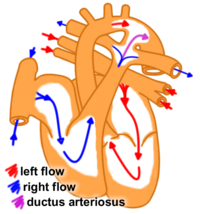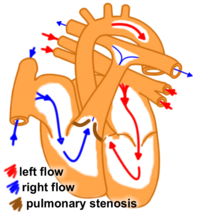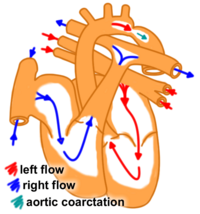Congenital heart defects
There are two types of heart defects: cyanotic and non-cyanotic.
Non cyanotic
This is the type of disorder that, although causes difficulties, doesn't affect the blood oxygen level. They are more common, because they are less serious for the patient.
Ventricular septal defect
These are the most common congenital heart problems. Usually asymptomatic, with a pansystolic murmur, and a parasternal thrill on examination. Failure to thrive is common. It can lead onto paediatric heart failure. Most VSDs will close up on their own in the first few years of life, but around 10% will require surgery.
Patent ductus arteriosus
Again, the ductus arteriosus can fail to close. This is more serious however, since the higher pressure in the aorta than the pulmonary artery means that there is a left-to-right shunt, and the child can suffer from laboured breathing and failure to thrive. There is also an high possibility of congestive heart failure if the patent duct is not closed surgically.
Pulmonary stenosis
Like many of these, most patients with pulmonary stenosis are asymptomatic. Some patients can be duct dependant if not enough blood is getting through to adequately perfuse the lungs. These present early. In most, an ejection systolic mumur can be heard, radiating to the back.
As with adults, progressive hypertrophy on the right side will occur, and reduced exercise tolerance over time. The most common treatment in kids is transvenous balloon dilation. If this doesn't work, next comes valve replacement.
Atrial septal defect
I don't really understand the textbook on this one, but basically, the septum (wall) in the atria has a hole in it, with the foramen ovale not closing or leaking. Often no clinical features, although there can be a split second heart sound. Generally if detected, patients are offered closure surgery; even though there is no evidence to support this. Inpatients are commonly heard to remark when given sprouts for hospital dinner, "I need this like I need a hole in the hear... OH GREAT, ALREADY GOT THAT ONE!". This can be diagnostic.
Rarer, but can happen is the artioventricular septal defect. Most commonly seen in Down's syndrome.
Coarctation of the aorta
This is where there's a narrowing in the aorta.
It can be minor, and doesn't interfere with life, or it can be severe, and be duct dependant, needing the ductus arteriosus to pass blood from the pulmonary artery in order for life to continue. Blood pressure in arms will be higher than in legs (since the blood comes off for the subclavian before the narrowing.
Treatment is surgery, with resecting or other exciting methods. Death rate for this condition is around the 2% level; not too bad really.
Aortic stenosis
Like with pulmonary, this can be asymptomatic. For some reason, its four times more like in men. Main symptom is increased fatigueability. Can cause heart failure, generally in adolescence. Listen for an ejection systolic murmur.
Cyanotic
In these disorders, the flow of blood round the heart is so messed up that oxygenated blood is not perfused through the body properly, hence the kids can look blue, or be centrally cyanosed.




